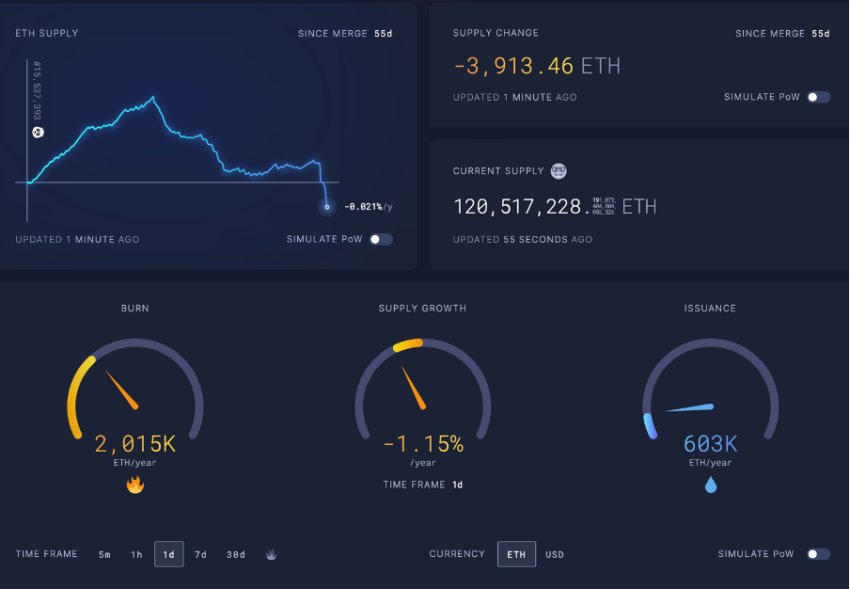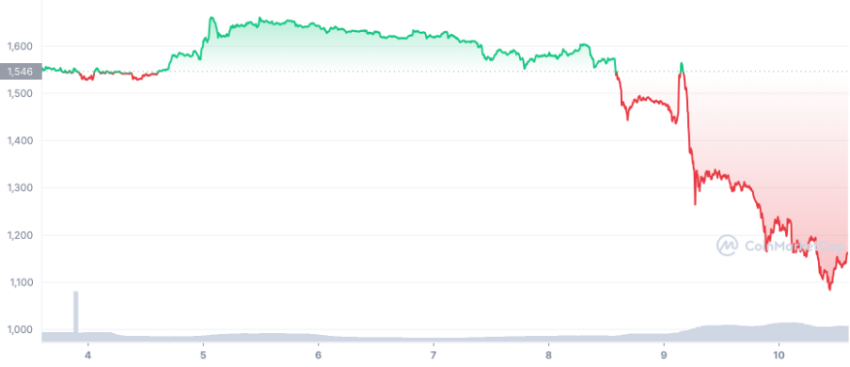Ethereum achieves ‘zero net issuance’ 55 days after the much-anticipated Merge. Deflationary, ultra sound money status is intact. But the ETH price falls by more than 18% – still bleeding.
There’s a growing meme that has been circulating now amidst the crypto turmoil that says: “Can crypto make me a millionaire? Yes, if you are already a billionaire.”
It highlights the crypto crash. After all, the crypto market lost more than 14%, and the market capitalization stands below the $800 billion mark. Quite a sad day, to say the least, if you’re a crypto enthusiast. But here’s something that might cheer you.
Remember Ethereum, the largest altcoin, and its much-anticipated Merge that went live on September 15 this year? Ethereum’s transition from the Proof-of-Work (PoW) mainnet and execution layer to the Proof-of-Stake (PoS), ‘Eth2’ Beacon Chain consensus layer?
Ethereum: The Merge
Here’s one representation for all the Dragon Ball Z fans out there:

The deflationary tree has FINALLY started to bear fruits.
BeInCrypto reported in September, just before the Merge, highlighting the what, why, and when questions. Now almost two months down the line – here’s an update on Ethereum for all the crypto enthusiasts.
To summarise this event quickly, ETH’s issuance and supply structure changed during that transition. ‘Previously, new ETH was issued from two sources: the execution layer (i.e., Mainnet) and the consensus layer (i.e., Beacon Chain).’
Since The Merge, issuance on the execution layer is now zero. Let’s narrow it down.
ETH Turns Deflationary
Two key concepts come into the picture here, given their relation to Ethereum: a deflationary asset and ultra sound money.
Two groups of currencies, mainly inflationary and deflationary, exist. The former has no limit on how many units are in circulation, whereas the latter has a maximum supply. Other factors remain constant; the buying power of inflationary currencies reduces as more units are printed.
Fiat currencies, like the USD, fall under the inflationary umbrella.

For instance, a hundred years ago, one could buy 15 coffees at McDonald’s for $1.
Inversely, the value of deflationary currencies increases with time as the currency becomes more scarce or sound money ever. I.e., not susceptible to sudden price increases or long-term declines in purchasing power.
Bitcoin, the largest cryptocurrency, has a maximum cap of 21 million. Post which, no more ‘new’ Bitcoin. Hence justifying the deflationary status. This finite scarcity of the asset, coupled with the lack of centralized control, enables many to view bitcoin as a very sound asset.
Upgraded Version of Sound Money
The emerging asset class, emerging narratives, everything is happening in the crypto sector. One of these notions is ultra sound money, which Justin Drake, an Ethereum Foundation researcher, popularized.
Unlike Bitcoin, Ethereum’s supply wasn’t fixed. But following the rise of ETH after Merge, the ‘Ultra Sound Money’ narrative came into the picture. For instance, sound money is an asset with a fixed supply, and its value increases over time.
Meanwhile, ultra sound money is an asset with a declining total supply (deflation), and (value) increases over time.
With ETH being a deflationary asset and after introducing a fee-burning mechanism with the EIP-1559 upgrade, the concept of ultra sound money came into existence.
The Breakdown
Consider the following scenario to understand the concept of ultra sound money:
Pre-Merge, the number of ETH issued per day: (1) Block Reward for miners + (2) Reward for PoS stakers – (3) ETH burned from EIP-1559.
Here’s a sample pre-Merge issuance picture per the official Ethereum blog on November 8.

They are moving on to the post-Merge scenario. Following the transition, block rewards are no longer generated on the Execution Layer or the mainnet. The blog added:
“Proof-of-work is no longer a valid means of block production under the upgraded rules of consensus. All execution layer activity is packaged into “beacon blocks,” which are published and attested to by proof-of-stake validators. Rewards for attesting to and publishing beacon blocks are accounted for separately on the consensus layer.”
Then, the total amount of newly issued ETH, given that Execution layer issuance since The Merge is zero, will be calculated as follows: (2) Reward for PoS stakers – (3) ETH burned from EIP-1559
Expectation: the number of network users will continue to increase to the point where the amount of ETH burned from EIP-1559 exceeds the amount of ETH used as incentives for stakers. From then, ETH will start to deflate.
But did the expectation(s) match the reality in the present day?
The Ultra Sound Money
Indeed, the expectation vs. reality has come true for the largest altcoin and the second largest cryptocurrency.
Data shows that more than 3,000 ETH, worth more than $4 million, was burned, attaining the deflationary status. The number of new ETH being created is less than the amount of ETH burned.

ETH’s total supply has sharply declined, reaching an inflation rate of 0.021% per year. This is a promising sign that Ethereum will become a deflationary or at least a highly low-inflationary crypto.
The term ultra sound money has been frequently used by Ethereum enthusiasts pre and post Merge. But it wasn’t until now that this term was genuinely justified. This change will result in Ether holders being able to stake ETH for a return of 4-5% (at present, 4.3%).
One of the many reasons why many support the ultra sound money viewpoint for Ethereum. This event would boost ETH’s adoption probability, both institutional and retail.
Fears and Concerns
Critics say that Ethereum could ultimately become a centralized entity. Deep-pocket investors may absorb large amounts of ETH, eventually dominating much of the network.
Dune Analytics shows that Lido has the most significant ETH stake, with 4,529,312 Ether in staking or 30.4% of the total pool. Coinbase (13.89%) and Kraken (7.99%) took the 2nd and 3rd, respectively.

The problem with this centralization is that investors or companies holding these large amounts of money could be attacked by freezing their funds, thus affecting the Ethereum network.
The new chain could give major stakers – the guys that secure the Ethereum network – the power to block transactions in compliance with regulatory demands and against the cryptocurrency ethos of privacy and decentralization.
Another major concern is Ethereum’s censorship. One website, MEV Watch, shows that some MEV-Boost relays are regulated under OFAC and can censor certain transactions. Ergo, countering the very concept of decentralization.
Currently, 71 % of Ethereum blocks are compliant with OFAC regulations. This number has significantly increased compared to September end, which stood at 25%.

Herein, OFAC is the Office of Foreign Assets Control, which enforces United States economic sanctions. The same regulatory body that sanctioned Tornado Cash and addresses associated with it.
Flashbots, the largest MEV-Boost relay, refuses to process any transaction related to the mixing protocol Tornado Cash.
Price Crashing Down
Ethereum’s native token, ETH, witnessed yet another correction, erasing its past gains. At the time of press, ETH slid down to the $1,169 mark on CoinMarketCap after seeing a fresh 10% setback in 24 hours.

But this was mainly due to the Binance-FTX insolvency fiasco.
Got something to say about this article or anything else? Write to us or join the discussion in our Telegram channel. You can also catch us on TikTok, Facebook, or Twitter.
The post Ethereum Becomes Ultra Sound Money But Remains Vulnerable to Censorship appeared first on BeInCrypto.



 (@drakefjustin)
(@drakefjustin)